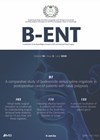
Journal Reviews archive for 2021
Surgery safety checklists
The time-outs were based on pre-flight checklists adopted by airline pilots and were instituted in all accredited hospitals and ambulatory care centres in the United States in 2003. The guidelines originate from general surgery and are not specific for the...
Is there a limitation for excising parapharyngeal tumours transorally?
The parapharyngeal space is a complex anatomical space bounded medially by the oropharynx and laterally by the mandible. It is conceptualised as an inverted pyramid extending from base of skull above to the hyoid bone below. The space is divided...
A therapeutic algorithm for tracheoesophageal periprosthetic leakage
Tracheoesophageal voice prosthesis leakage can be intravalvular (more common) or periprosthetic (focus of this study). The authors studied the causes of periprosthetic leakage among 115 patients attending for voice prosthesis management (1374 clinic attendances) treated between December 2014 to December...
When should revision FESS leave you reaching for the script pad?
This very interesting work from the professorial team in London seeks to define a group of patients with CRSwNP who may benefit from early biological treatment since they are at risk of failure of surgical and conventional medical management. Approximately...
Patient-reported outcome measures: what do the people say?
Patient-reported outcome measures (PROMs) assess and quantify health outcomes from the patient’s perspective. Defining these questionnaires as outcomes indicates that they are psychometrically sensitive to change. This article describes three PROMS: namely the Patient Reported Outcome Measurement Information System (PROMIS),...
Remote consultations: bringing ENT in to the 21st century
The ongoing peaks and troughs of the COVID-19 pandemic have imposed unprecedented challenges on day-to-day healthcare provision that we all took as given across the globe prior to spring 2020! The pandemic has, in many ways, made us push boundaries...
Which factors affect the postoperative CSF leak following endoscopic skull base surgery?
Endoscopic skull base surgery is being increasingly performed worldwide for skull base tumours. Common indications include pituitary tumours, rathke cleft cysts, chordomas, craniopharyngiomas and olfactory neuroblastomas. The most common and important complication following endoscopic skull base surgery is postoperative CSF...
Coblation for lingual haemangiomas
Haemangiomas are benign vascular tumours characterised histologically by a marked proliferation of blood vessels. They can be either congenital or acquired, and can affect the tongue, both within the oral cavity and the oropharynx. A variety of interventions exist for...
CRS vs. migraine: which is the culprit in most headaches?
‘Sinus headache’ is a common diagnosis according to patients and primary care physicians, but relatively infrequent in the eyes of otolaryngologists. This study examines 104 patients with a primary headache syndrome (PHS) and 130 patients with CRS, looking at SNOT-22...
Age and vocal cord carcinoma
As the population ages, the management of vocal fold carcinomas should be evaluated. In this retrospective study on 33 patients aged 75 and more, the authors compared the results of radiotherapy and endoscopic treatment for T1 and T2 glottic carcinoma....
Semicircular canal dehiscence and cochlear implantation
Semicircular canal dehiscence (SCD) is thought to occur in 3% of the population, it is mostly asymptomatic, but patients may present with sound-induced vestibular symptoms, low-frequency conductive hearing loss, autophony, hyperacusis and aural fulness. With the increasing utilisation of cochlear...
Management of postoperative cholesteatoma
This prospective longitudinal observational study compared the ability of second-look surgery with that of surveillance using serial non-echo-planar diffusion-weighted imaging to detect residual cholesteatoma after canal wall-up mastoidectomy. A total of 34 patients were included in the study who underwent...

















